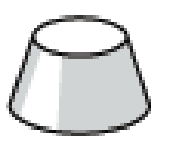
Identify solid figures, including prisms, cubes, cones, cylinders, pyramids, spheres, and frustums.
- (a)
 _____________________
_____________________ - (b)
 _____________________
_____________________ - (c)
 _____________________
_____________________
(a)
To identify: The given solid figure.
Answer to Problem 1P
The given solid figure is a
Explanation of Solution
From the given figure, observe that the given solid object has 6 equal sized square faces with three meeting at each vertex.
It is known that. a cube is a three dimensional object with 6 identical square faces with three edges meeting at each vertex.
Therefore, the given solid figure is a
(b)
To identify: The given solid figure.
Answer to Problem 1P
The given solid figure is a
Explanation of Solution
From the given figure, observe that the given solid object has 2 identical ends and 6 faces that are rectangles.
It is known that. a prism is a solid object with 2 identical ends and flat sides and a rectangular prism is a solid object with 6 faces are rectangles.
Therefore, the given solid figure is a
(c)
To identify: The given solid figure.
Answer to Problem 1P
The given solid figure is a
Explanation of Solution
It is known that the frustum of a cone is formed from a right circular cone by cutting of the tip of the cone in such a way that the cut is perpendicular to the height and forms the lower base and the upper base are circular and parallel.
From the given figure, observe that the given solid object is a cone and has an upper and a lower circular base with the upper base is parallel.
Therefore, the given solid figure is a
Want to see more full solutions like this?
Chapter 9 Solutions
Mathematics for the Trades: A Guided Approach (11th Edition) (What's New in Trade Math)
- 8. An elementary single period market model has a risky asset with price So = 20 at the beginning and a money market account with interest rate r = 0.04 compounded only once at the end of the investment period. = = In market model A, S₁ 10 with 15% probability and S₁ 21 with 85% probability. In market model B, S₁ = 25 with 10% probability and S₁ = 30 with 90% probability. For each market model A, B, determine if the model is arbitrage-free. If not, construct an arbitrage. Total [9 Marks]arrow_forwardb) Solve the following linear program using the 2-phase simplex algorithm. You should give the initial tableau, and each further tableau produced during the execution of the algorithm. If the program has an optimal solution, give this solution and state its objective value. If it does not have an optimal solution, say why. maximize ₁ - 2x2+x34x4 subject to 2x1+x22x3x41, 5x1 + x2-x3-×4 ≤ −1, 2x1+x2-x3-34 2, 1, 2, 3, 40.arrow_forwardSuppose we have a linear program in standard equation form maximize cTx subject to Ax = b. x ≥ 0. and suppose u, v, and w are all optimal solutions to this linear program. (a) Prove that zu+v+w is an optimal solution. (b) If you try to adapt your proof from part (a) to prove that that u+v+w is an optimal solution, say exactly which part(s) of the proof go wrong. (c) If you try to adapt your proof from part (a) to prove that u+v-w is an optimal solution, say exactly which part(s) of the proof go wrong.arrow_forward
- a) Suppose that we are carrying out the 1-phase simplex algorithm on a linear program in standard inequality form (with 3 variables and 4 constraints) and suppose that we have reached a point where we have obtained the following tableau. Apply one more pivot operation, indicating the highlighted row and column and the row operations you carry out. What can you conclude from your updated tableau? x1 x2 x3 81 82 83 84 81 -2 0 1 1 0 0 0 3 82 3 0 -2 0 1 2 0 6 12 1 1 -3 0 0 1 0 2 84 -3 0 2 0 0 -1 1 4 -2 -2 0 11 0 0-4 0 -8arrow_forwardMicrosoft Excel snapshot for random sampling: Also note the formula used for the last column 02 x✓ fx =INDEX(5852:58551, RANK(C2, $C$2:$C$51)) A B 1 No. States 2 1 ALABAMA Rand No. 0.925957526 3 2 ALASKA 0.372999976 4 3 ARIZONA 0.941323044 5 4 ARKANSAS 0.071266381 Random Sample CALIFORNIA NORTH CAROLINA ARKANSAS WASHINGTON G7 Microsoft Excel snapshot for systematic sampling: xfx INDEX(SD52:50551, F7) A B E F G 1 No. States Rand No. Random Sample population 50 2 1 ALABAMA 0.5296685 NEW HAMPSHIRE sample 10 3 2 ALASKA 0.4493186 OKLAHOMA k 5 4 3 ARIZONA 0.707914 KANSAS 5 4 ARKANSAS 0.4831379 NORTH DAKOTA 6 5 CALIFORNIA 0.7277162 INDIANA Random Sample Sample Name 7 6 COLORADO 0.5865002 MISSISSIPPI 8 7:ONNECTICU 0.7640596 ILLINOIS 9 8 DELAWARE 0.5783029 MISSOURI 525 10 15 INDIANA MARYLAND COLORADOarrow_forwardThe spread of an infectious disease is often modeled using the following autonomous differential equation: dI - - BI(N − I) − MI, dt where I is the number of infected people, N is the total size of the population being modeled, ẞ is a constant determining the rate of transmission, and μ is the rate at which people recover from infection. Close a) (5 points) Suppose ẞ = 0.01, N = 1000, and µ = 2. Find all equilibria. b) (5 points) For the equilbria in part a), determine whether each is stable or unstable. c) (3 points) Suppose ƒ(I) = d. Draw a phase plot of f against I. (You can use Wolfram Alpha or Desmos to plot the function, or draw the dt function by hand.) Identify the equilibria as stable or unstable in the graph. d) (2 points) Explain the biological meaning of these equilibria being stable or unstable.arrow_forward
- Question 1: Evaluate the following indefinite integrals. a) (5 points) sin(2x) 1 + cos² (x) dx b) (5 points) t(2t+5)³ dt c) (5 points) √ (In(v²)+1) 4 -dv ขarrow_forwardSuppose the Internal Revenue Service reported that the mean tax refund for the year 2022 was $3401. Assume the standard deviation is $82.5 and that the amounts refunded follow a normal probability distribution. Solve the following three parts? (For the answer to question 14, 15, and 16, start with making a bell curve. Identify on the bell curve where is mean, X, and area(s) to be determined. 1.What percent of the refunds are more than $3,500? 2. What percent of the refunds are more than $3500 but less than $3579? 3. What percent of the refunds are more than $3325 but less than $3579?arrow_forwardFind the indefinite integral. Check Answer: In(5x) dx xarrow_forward
- Algebra & Trigonometry with Analytic GeometryAlgebraISBN:9781133382119Author:SwokowskiPublisher:Cengage
